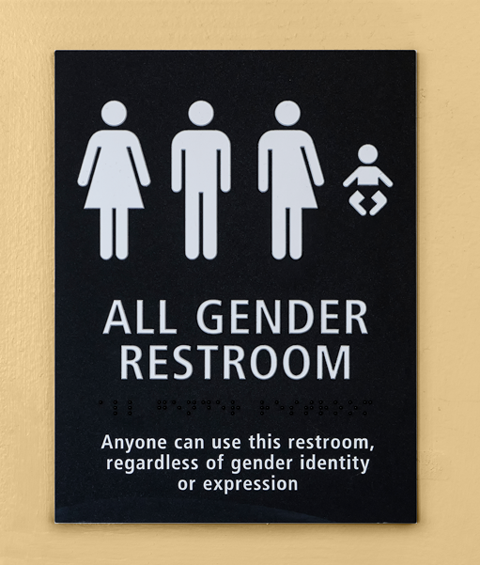Information for Supervisors and Human Resources Personnel
While it is expected that all New York State employees will treat their transgender and gender nonconforming (TGNC) colleagues appropriately, supervisors and Human Resources personnel have even greater responsibilities. They play a critical role in providing guidance to TGNC individuals and ensuring that policies regarding TGNC individuals are enforced.
Click the links with  to jump directly to that section on this page.
to jump directly to that section on this page.
- Dress and Grooming Policies
- Signage, Greetings, and Introductions
- Bathrooms, Facilities, and Program Policies
- Résumé Review and Interview Process
- Employment Identification, Records, and Systems
- Medical Leave and Confidentiality
- Transition Planning: Guidance for Supervisors and Human Resources Personnel
- What Not to Do
Dress and Grooming Policies
Dress codes, grooming practices, uniforms, appearance standards, and choice of clothing may be important for transgender and gender nonconforming (TGNC) employees to affirm their gender identity and expression. Additionally, if an individual is beginning to transition, they may start to dress, live, and act in accordance with the gender with which they identify prior to undergoing any gender-affirming medical treatment. Everyone has the right to choose when they want to begin dressing or living in a manner consistent with their gender identity. Agencies must allow them to do so regardless of whether they take steps to make a medical or legal transition.
State agencies may not require that employee dress codes, uniforms, grooming, or appearance standards differ based on gender identity, sex, or sex stereotypes. Dress codes must be applied consistently regardless of gender or gender identity.
Rae identifies as a lesbian woman. She usually wears a button-down shirt and dress pants to work. One day, Rae wears a button-down shirt with a skirt. When she gets to the office, her co-workers make comments about her "interesting new look" and uncomfortably stare at her legs. Rae feels that this might be because of her leg hair. Later that day, Rae's supervisor calls her into his office. He tells her that she should not wear a skirt unless she shaves her legs because it is "unprofessional."
Rae's supervisor is imposing a different grooming policy on Rae based on her gender. His idea of professionalism is based on the sex stereotype that women should not have body hair. Supervisors should apply policies about appearance and grooming standards equally, regardless of gender, gender identity, sex, or sex stereotypes. State agencies are encouraged to evaluate their dress code, uniform, grooming, and/or appearance policies and determine if the policies are necessary for the job position.
Jesse is a transgender man who works in a job with two slightly different sets of uniforms; one set is usually issued to men and the other is usually issued to women. When Jesse requests to wear the "men's" uniform, his supervisor says "of course" and promises to follow up. The supervisor then informs Jesse that she is sorry, but they do not make the men's uniform in a size small enough for him. She then says that the differences between the two sets of uniforms are not that noticeable. The supervisor asks Jesse if he would be willing to wear the women's uniform instead.
Agencies may provide different uniform options for employees, such as one uniform shirt that is styled like a blouse and another that is styled like a button-down. However, it is prohibited to require an employee to wear one style over another because of gender, sex, or sex stereotypes. In general, each uniform style should be available to all employees regardless of gender identity. State agencies must allow employees to dress consistently with their gender identity. Agencies may need to special order specific sizes for employees if they do not have them available.
To Top
Signage, Greetings, and Introductions
New York State employees look to management to model inclusive workplace culture. Supervisors and Human Resources personnel are often considered management and are encouraged to think about ways to display inclusive behavior. This could include actions such as displaying visible literature, signs, or posters that show they are knowledgeable and open to talking about transgender and gender nonconforming (TGNC) or LGBTQ+ issues.
Supervisors and Human Resources personnel can also demonstrate inclusive workplace culture by being intentional about their greetings and introductions in person, over the phone, and/or in e-mail. Greetings that use gender-neutral language are preferred.
Another best practice is for supervisors and Human Resources personnel to consider providing their own gender pronouns during introductions; this demonstrates and normalizes the importance of using correct pronouns in the workplace. For example, "My name is Jenny. I work in the Human Resources department, and I use the pronouns she/her/hers."
Including gender pronouns in meeting introductions should always be optional since it can force transgender employees to out themselves.
It is a violation of the State's antidiscrimination policy to refuse to refer to an individual by their name and designated pronouns. It is also a violation of the State's Human Rights Law to deliberately not refer to an individual by their requested name and pronouns with or without a legal name change. See https://dhr.ny.gov/genda.
For more information on the topic of gender-neutral greetings and introductions, see Serving Transgender and Gender Nonconforming Customers.
To Top
Bathrooms, Facilities, and Program Policies
State agencies must allow employees to use gender-separated facilities, such as bathrooms and locker rooms, and to participate in gender-separated programs consistent with their gender identity regardless of their appearance, anatomy, medical history, sex assigned at birth, or gender indicated on identification and without requiring proof of gender identity. Agencies are encouraged to provide a gender-neutral option for segregated facilities when possible. However, individuals must be allowed to use the facility or service that corresponds with their gender identity. Failure to permit this is an unlawful discriminatory practice under the State's Human Rights Law.
Consistent with a recently-enacted law, all single occupancy bathrooms in State-owned or -operated buildings and office spaces are required to be gender neutral. Agencies having single occupancy bathrooms that are not signed as gender neutral should contact the Office of General Services for new signage.
Charlie identifies as nonbinary and uses the pronouns they/them/theirs. The only gender-neutral bathroom at their worksite is on a different floor. Charlie chooses to use the nearby women's bathroom because that is where Charlie feels the safest. One day, a new colleague enters the bathroom and gasps. Looking at Charlie, she asks, "Am I in the right bathroom?" Later, she complains to Charlie's supervisor about there "being a man in the women's bathroom." The supervisor calls Charlie into her office and asks Charlie if they can use the gender-neutral bathroom from now on because other employees are uncomfortable using the same bathroom as them. When Charlie refuses, the supervisor says, "What does it say on your driver's license? Show me some proof and then you can use the women's bathroom."
The supervisor should not have asked Charlie to use the gender-neutral bathroom because another employee was uncomfortable. Charlie has a right to use the bathroom most consistent with their gender identity and safety, regardless of appearance, anatomy, medical history, sex assigned at birth, or gender shown on identification. Supervisors cannot require proof of gender identity before allowing an individual to use a gender-separated facility or program. Furthermore, State agencies can make gender-neutral bathrooms accessible to all employees without logistical barriers, such as significant travel time to another floor, department, or building.
The agency cannot require a transgender and gender nonconforming (TGNC) person to use a different bathroom to accommodate a complaining employee or customer. If an individual expresses discomfort with sharing a gender-separated facility, the agency may accommodate that individual by allowing them to use a single-occupancy facility, such as a family-style or accessible bathroom.
The Governor's Office of Employee Relations can answer any questions concerning facilities or bona fide occupational qualifications for a position.
To Top
Résumé Review and Interview Process
Supervisors and Human Resources personnel must evaluate potential employees based on their skills and qualifications for a position regardless of their gender identity or sex. It is illegal for supervisors to make decisions about employment based on sex stereotypes.
During the interview process, supervisors and Human Resources personnel should not assume an individual's gender identity or the pronouns they use based on the name listed on their résumé, their work experience in a particular field/employer, and/or the way they look during the hiring and interview process. The only way to know an individual's gender identity or the pronouns they use is if they tell you. During the interview process, it is appropriate to use the individual's name until you know the correct pronouns to use. Using incorrect pronouns or misgendering a candidate could make the applicant view the agency as a disrespectful place of employment. Deliberate misuse of pronouns or names is unlawful discrimination. Interviewers can introduce themselves with their pronouns to normalize this discussion. For more information on pronoun use, please see Names and Pronouns: Talk to Me.
Employers should be aware that transgender and gender nonconforming (TGNC) employees may have records that do not match their current name or gender, such as college transcripts, military service records, or professional certifications, because these are often difficult or impossible to change.
Additionally, when making an offer of employment, it may be appropriate to proactively ask the employee how they want their name listed on workplace identification, such as a company directory or nameplate.
Sal is a cisgender woman who applies for an executive assistant position. She attends the interview with her hair cut short, no make-up or jewelry, and wearing a suit, tie, and wingtip shoes. After Sal greets the receptionist at the front desk, she hears the receptionist ask the management team, "Are you ready for your 3:00 candidate? He's here at the front desk."
The receptionist assumes Sal's pronouns and gender identity based on Sal's gender presentation and appearance. Determining how to address an individual and what pronouns to use should be based on the name and pronouns expressed by the individual and never on gender identity, expression, appearance, sex stereotypes, or transgender status.
To Top
Employment Identification, Records, and Systems
Employees may wish to change the name associated with systems used for their employment. Some changes can be made without a name change court order. Here are examples of items that can be changed without a court order and examples of items that require one.
| No Court Order Required |
Court Order Required |
| E-Mail Address |
State ID |
| SLMS E-Mail Address |
Driver's License |
| Name Placard |
Payroll Forms |
| Website Pages/Directories |
Tax Forms |
| Organizational Charts |
LATS |
| Mailing Lists |
Health Insurance |
| |
Retirement Benefits |
| |
SLMS Account Information |
If an employee without a name change court order asks about changing their name in various employment systems, the supervisor or Human Resources personnel should advise the employee of which systems can be changed without an order. Human Resources personnel should be able to update items such as a website, organizational charts, agency intranet, name placards, and mailing lists without encountering barriers related to the name change.
To change an e-mail address, the employee should send a help desk ticket to ITS stating that they are requesting a name change. No documentation is needed for an individual to change the name associated with their government e-mail address.
To change the e-mail address associated with their Statewide Learning Management System (SLMS) account, the employee can log in to their SLMS account and update the address in their profile. No documentation is needed to make this change. The name and gender marker used in the SLMS system are generated based on information in NYS Payroll. It cannot be updated until payroll records have been updated.
If an employee has a name change court order, Human Resources personnel can process changes as they would any other name change. Agencies hosted by the Business Services Center (BSC) at the Office of General Services can have employees submit a Personal Data Change Form to BSC to begin the process.
Once an employee has obtained a name change court order, they will need to apply for new identification documents (e.g., driver's license, birth certificate, Social Security card, passport) if they have not already done so. The requirements can be found on each agency’s websites:
Refusing to change employment records to the lawful name of a transgender person is unlawful discrimination.
To Top
Medical Leave and Confidentiality
Transgender and gender nonconforming (TGNC) individuals may request time off from work for medical reasons related to their TGNC status. In keeping with appropriate behavior towards all personnel, supervisors should permit the use of appropriate leave for TGNC individuals to attend appointments and rehabilitation related to their gender identity or transition. Supervisors should treat time off for medical appointments, procedures, rehabilitation, and reasonable accommodations in the same manner as requests for other health or medical conditions.
If another employee asks about a transgender individual's absence while they are undergoing medical treatment, supervisors and Human Resources personnel should answer the question like any other question about leave. For example, a supervisor could say, "They are on leave until X date and, as with any medical leave, it's not appropriate to discuss why."
New York State agencies provide health benefit plans that cover gender-affirming or transition-related care. Employees with specific questions about what their health insurance covers can contact the agency's health benefits administrator or the insurance plan. They can also check the summary of benefits and coverage available on the Department of Civil Service website. Information related to medical leave or health insurance must be kept confidential.
In addition to discussing medical leave or insurance requests, TGNC employees have the right to discuss their gender identity or expression and to have that information kept private. Employees have the right to decide when, with whom, and how much of their private information to share, including information about their gender identity, expression, sex assigned at birth, transgender status, and medical history. This information can constitute confidential medical information that is protected under various state and federal laws including, but not limited to, the Americans With Disabilities Act, the Family and Medical Leave Act, and New York Labor Law.
Supervisors, Human Resources personnel, and co-workers cannot share information that may reveal an employee's confidential medical information to others. Any supervisor, Human Resources personnel, or co-worker must obtain the TGNC employee's consent prior to disclosing any confidential information. Gossip or speculation about an individual's gender identity is inappropriate and may be an unlawful discriminatory practice.
To Top
Transition Planning: Guidance for Supervisors and Human Resources Personnel
Employees who decide to transition or use a new name, gender pronoun, and/or affirm a new gender identity have a right to do so and receive support from management. Supervisors and Human Resources personnel should proactively discuss how their agency handles transition planning with agency leadership, rather than wait for an employee to approach them with questions.
Supervisors and Human Resources personnel may be the first point of contact for an individual who feels comfortable disclosing information about their gender identity, expression, use of a new name or pronoun, and/or transition. In these situations, keep in mind that the employee's needs may change over time. To address their initial needs, the employee may develop a plan that includes several components. Supervisors and Human Resources personnel must be prepared to help the employee with:
- Identifying stakeholders, such as supervisors, coworkers, or constituents who the employee may need to engage in the process;
- Creating a communication and timing plan;
- Working with the employee to identify which workplace records, systems, and/or forms of identification need to be changed. See Employment Identification, Records, and Systems for more information;
- Determining the date on which the employee wants to begin using a new name or presenting themself in a manner consistent with their gender identity;
- Identifying periods where the employee may need to use leave or may need reasonable accommodations due to gender identity, expression, transitioning, or transgender status;
- Identifying any specific areas of high priority or concern that require immediate attention; and
- Identifying a main point of contact for communications (i.e., will it be the employee or a member of their support team?).
Supervisors and Human Resources personnel should work with the employee to create a plan that works for them and the agency. The plan may include a legal name change or may only include changes that can be made without a legal name change. It is important to be aware that each individual has a different experience, that their experience and needs may change over time, and that Human Resources personnel should help them transition in the workplace as easily as possible.
Supervisors and Human Resources personnel wanting further guidance may also wish to contact the Employee Assistance Program (EAP). EAP is a confidential, worksite-based program designed to help State employees with the everyday issues involved in balancing work and life as well as more serious problems that may impact work performance. EAP services are confidential, voluntary, and offered at no cost to employees and their families. EAP coordinators consult with management, supervisors, and union leaders about workplace issues, the benefits of early referral to EAP, and how to make a referral.
Employee Assistance Program: 1-800-822-0244
To Top
What Not to Do
Certain actions are never acceptable in response to an employee transitioning in the workplace and may be a violation of the law. Examples include:
- Outing an individual. Information about an employee's gender identity, gender expression, sex assigned at birth, previous name or gender pronouns, transition, medical information, reason for medical leave or accommodations, and/or transgender status should not be shared without the employee's consent. Supervisors or Human Resources personnel may learn about an employee's transgender status or medical information during the normal course of business; this information may constitute confidential medical information that is protected under State and federal law. It should always be kept confidential.
- Forcing an individual to discuss or explain their transition with other employees. An individual cannot be required to discuss or explain their transition, gender identity, expression, and/or transgender status. It is never appropriate to force a transgender employee to educate other employees about their identity. Managers and Human Resources personnel should consider providing training opportunities to employees who need more information.
- Forcing an employee to act in ways inconsistent with their gender or gender identity. Employees have the right to use the name, pronouns, title, bathroom, and facility that aligns with their gender identity. They also have a right to dress in accordance with their gender identity and agency policy.
- Continuing to intentionally refer to an individual using a different name or pronoun than what the employee has stated what they would like to be called. This could constitute unlawful discrimination.
Please review the New York State Equal Employment Opportunity Handbook for more information on employee rights and responsibilities.

 to jump directly to that section on this page.
to jump directly to that section on this page.

